How I Spent 8 Days Solo Traveling in Japan Off the Beaten Path
This journey leads you through some of Japan’s beautiful natural and most sacred areas, so please remember to Leave No Trace and be respectful of the people and places you encounter. Also: this post contains affiliate links. I may earn a small commission at no cost to you if you make a purchase through them.
My first visit to Japan was one for the books. I spent 8 days solo traveling in Japan with a goal to make it an uncommon and epic trip off the beaten path. I couldn’t wait to take in the traditional temples and shrines, natural beauty, and delicious food. Going alone was a really special way to experience the unique culture and quieter, more peaceful side of Japan.
Within 36 hours after arriving in Tokyo, I was standing at the top of the country’s largest volcano, dipping into steaming hot springs, soaking in the spray of a waterfall, and having funny conversations via Google Translate.
This country is buzzing and lively in parts, but it’s also a treasure trove of natural beauty, from enchanting forests and mountain peaks to bamboo groves and tree-lined paths that seem to lead backward in time to dazzling temples and shrines. It’s almost twice as mountainous as my home state of California, and the hiking culture here proves it!
If you feel yourself being pulled toward Japan like a magnet, you’re not alone! It’s one of the top countries on traveler’s bucket lists for good reason.
I want to share how I spent 8 days solo traveling in Japan, offer some advice and tips to make your trip go as smoothly as possible, and give you some ideas on must-see places off the beaten path while you’re here.
You can watch videos from my adventure here:
- I Hiked Japan’s Largest Active Volcano—4-Day Kyushu Road Trip
- Glamping Under Mt. Fuji: Exploring Shizuoka’s Nature, Culture & Green Tea Traditions in Japan
- Highlights From My Solo Trip to Japan
Let me be your guide to exploring the nature, architecture, culture, and food that make Japan a destination I can’t wait to visit again!
My 8-Day Solo Japan Itinerary
This is my itinerary for 8 days of solo traveling in Japan. Click any link below to jump to that section!
Day 1: Arrive in Tokyo & Explore
- Arrive in Tokyo Narita at 5 p.m.
- Grab some snacks & nap
- Explore and get a feel for the city
Day 2: Kyushu Island’s Fukuoka & Kurume
- Fly to Fukuoka from Narita & rent a car
- Explore Fukuoka
- Day trip to Yamaguchi
- Drive to Kurume for shrines, temples, and traditional crafts
- Hotel: Green Rich Hotel Kurume
Day 3: Volcano Hike, Takachiho Gorge & Onbara Falls
- Drive to Mt. Aso region
- Hike Mt. Aso summit loop
- Kurokawa Onsen hot springs
- Drive to Takachiho Gorge
- Hotel: Ryokan Nanjoen
Day 4: The Heavenly ‘Hells of Beppu’ & Sand Bath
- Drive to Beppu
- Beppu Beach Sand Bath
- Hells of Beppu tour
- Dinner steamed in “hell”
- Onbara Waterfall
- Hotel: Uminohotel Hajime
Day 5: Planes & Trains to Kyoto
- Fly to Osaka
- Bullet train to Kyoto
- Hotel: Node Hotel Kyoto
Day 6: Kyoto Gardens, Palaces & Temples
- Kyoto National Gardens and Imperial Palace
- Kyoto Shinkyogoku Shopping Street
- Gion District
- Golden Pavilion temple
- Dinner
- Hotel: Node Hotel Kyoto
Day 7: Shizuoka Green Tea Plantation & Traditional Crafts
- Bullet train to Shizuoka Prefecture
- Mt. Fuji World Heritage Center
- Green tea plantation experience tour
- Hotel: Glamping at Mt. Fuji guest house
Day 8: Mt. Fuji Views, Traditional Crafts & Shiraito Falls
- Sunrise over Mt. Fuji
- Sumpu Takumi Shuku Traditional Crafts Center
- Guided Shiraito Falls tour in Mt. Fuji WHS
- Return to Tokyo
- Tokyo food tour & Nakameguro cherry blossom stroll

Day 1: Arrive in Tokyo & Explore the City
- Arrive in Tokyo Narita at 5 p.m.
- Grab some snacks & nap
- Explore and get a feel for the city
Touching down in Tokyo’s Shinjuku City tonight lets me know I’m in for something special! Sounds, lights, and delicious smells fill the air as people pack the busy streets in search of all things entertaining and tasty.
After my 12-hour flight from Los Angeles, I’ll be in the city for 16 hours. It’s just enough time to grab some sleep and a little food to officially say hello to Tokyo!
Konbini Eats & Midnight Exploring
Getting here around 11:30 p.m., I’m hungry and make it as far as a 7-Eleven konbini, or convenience store (trust me—it’s a big thing here!) around the corner from my hotel before I grab some staples: a sticky rice and Abucki bean dish, an amazing butter roll, and chocolate-covered mangoes. All delicious!
After a nap, I hit the streets to explore and wander through the closed-up food alleys now that it’s the middle of the night. This midnight to 6 a.m. period is the best time to check out the city and see a whole different side of Tokyo.
After fueling up with coffee and a unique cantaloupe cream-filled donut as a special treat, I’m already dreaming about the omakase (translates to “I’ll leave it up to you,” or chef’s choice) I hope to try later on!
Just after 9 a.m., it’s time to head to the airport for my flight to Fukuoka where my trip really starts. I’m heading further south to the island of Kyushu to get in touch with the more natural side of Japan!
-
- 👉 Find the perfect hotel
- 🚗 Rent a Car
- 🥾 Find a nearby Trail
- 🧳 Pack the perfect suitcase with these packing cubes
- 👉 All the gear you need for your adventure
- 📱Grab an E-Sim for travel abroad
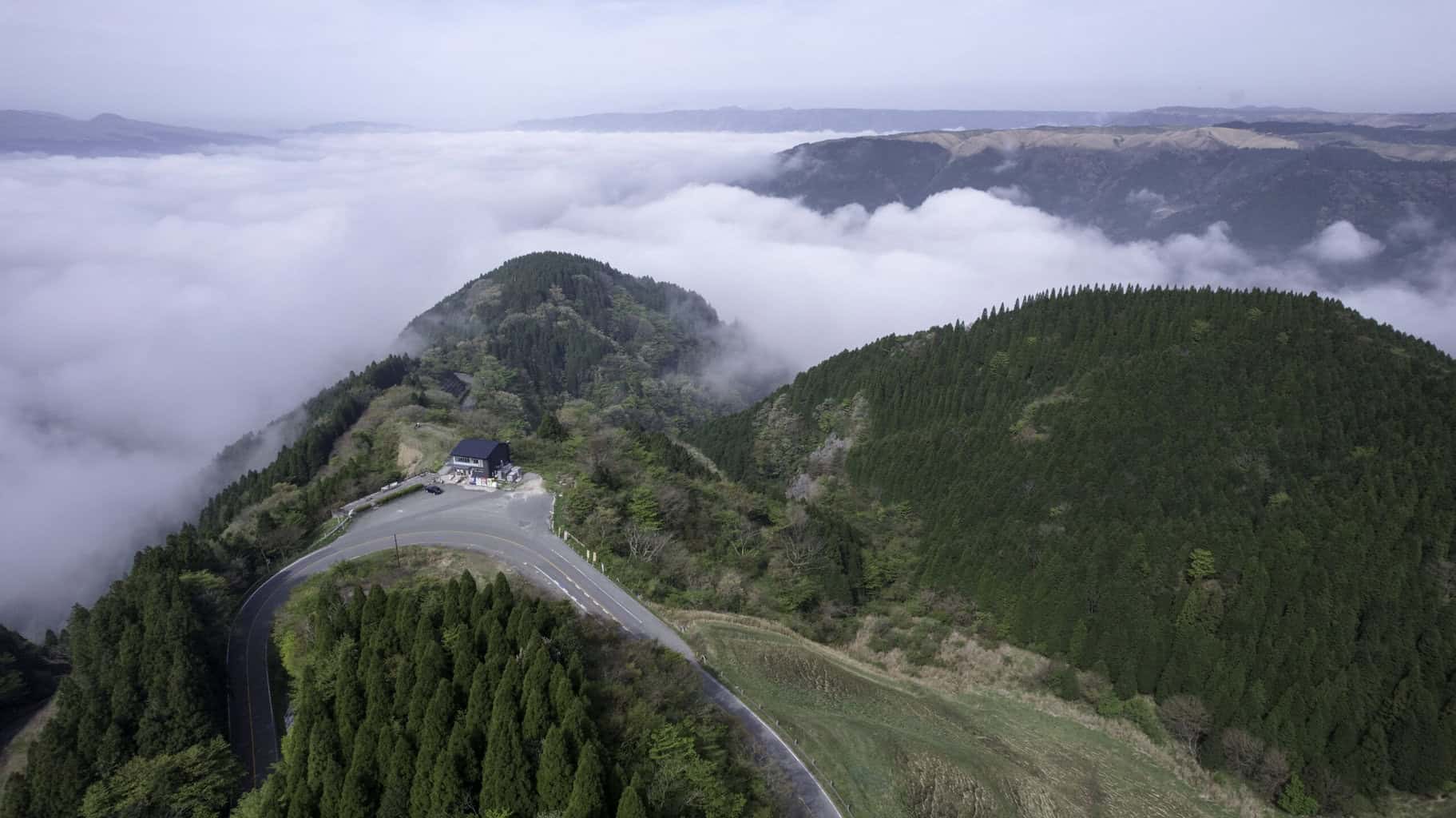
Day 2: Kyushu Island’s Fukuoka & Kurume
- Fly to Fukuoka from Narita & rent a car
- Explore Fukuoka
- Day trip to Yamaguchi
- Drive to Kurume for shrines, temples, and traditional crafts
- Hotel: Green Rich Hotel Kurume
Fukuoka Coastal Views & Parks
I catch a noon flight to Fukuoka on Kyushu Island’s northern shore. Now, this is the Japan I’ve been dreaming of! Mountains and volcanoes take over the views, secret temples and ruins appear out of nowhere, hot springs bubble and steam by hiking trails, and valleys dip low into the scenic landscapes all around me.
I chose Kyushu Island just for this reason. It’s one of the less-visited parts of the country for tourists, but it has some of the best hiking trails and is perfect to visit if you’re solo traveling in Japan. Some things to note about Fukuoka:
- Fukuoka has lots of beaches, shopping, and ancient temples.
- The central Hakata district is home to the Tōchō-ji Temple and its 10-meter wooden Buddha!
- Maizuru Park has 17th-century Fukuoka Castle ruins to explore.
Driving on the “wrong” side of the road takes some getting used to. But I’m on a mission to reach Yamaguchi and Amagase Park (about 2.5 hours)!
On the way, I catch some great views of the Sea of Japan and stop to visit Akama Shrine in Shimonoseki, which has a long history and is regarded as a power spot by the locals. Check out the Karato Fish Market nearby to grab some fresh sushi and seafood.
You’ll pass by the Hiraodai Karst Plateau, a limestone plateau and great hiking destination if you have extra time with chances to explore caves, birdwatch, and see massive limestone boulders.
Reaching Yamaguchi on Honshu Island shows me another side of Japan. It’s a coastal wonderland with huge markets, abundant seafood and sushi, and impressive landmarks like Tsunoshima Bridge.
The best views of the bridge are from Amagase Park, my next stop. Beautiful coastal views and glimpses of Tsunoshima Island make it gorgeous. Backtrack a bit and take photos at the clifftop Motonosumi Inari Shrine, one of Japan’s 31 most spectacular spots.
Heading back toward Fukuoka, I’m visiting Kurume next for a stunning display of azaleas, traditional shrines, and to learn about Japanese hand crafts.
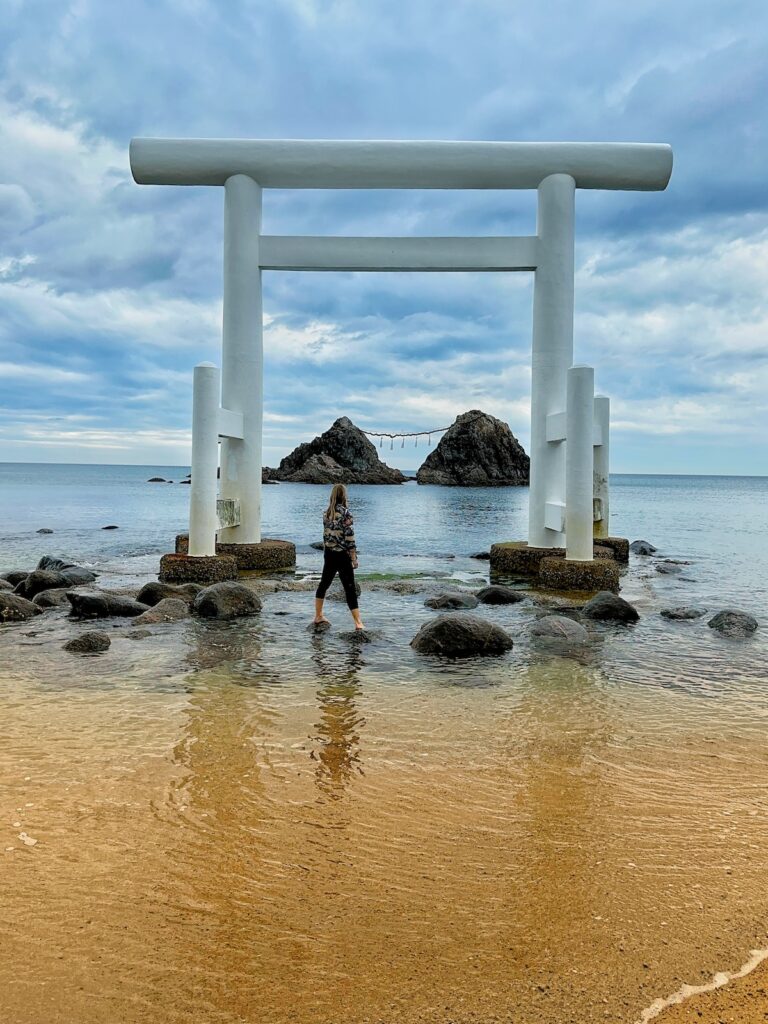
Kurume Traditions, Temples & Shrines
Kurume’s ancient water god temples and prolific azaleas are its claim to fame. About an hour south of Fukuoka, the Suiten-gū Shrine on the banks of the Chikugo River is on my list. The temples honor the God of Water and of Easy Childbirth. Nearby, the Bairin-ji Temple is known for its plum tree grove and Zen meditation.
Something I didn’t know when coming to Japan is the difference between a temple and a shrine. There are thousands of both in Japan, but temples tend to be grander, are tied to Buddhism, and may house monks. Shinto shrines are usually smaller and feature torii gates, but both share harmonic beliefs and ethics to stand side by side across Japan.
One thing that fascinated me enough to come check it out was Kurume’s kasuri, a traditional cotton fabric dyed with indigo that started in the 18th century. Some local shops still make the fabric according to tradition and it takes months. You can pick up sneakers and sundries to bring the tradition home!
I learned about Kurume rantai laquerware, or light and sturdy utensils covered in layers of lacquer. It takes on flavors as you cook with it and makes great chopsticks!
Azaleas Aplenty & Turning In
With a little time left over, the Kurume Forest Azalea Park and Kurume World Tsutsuji Center are the best places to see the blossoming azaleas. By traveling in April, I caught these in full bloom!
If you’re up for a local treat, try tonkotsu ramen with pork bone broth. It originated in Kurume and is one of Fukuoka ‘s most popular delicacies. My accommodations tonight: the Green Rich Hotel Kurume with natural hot springs. That’s a big win after a long day!
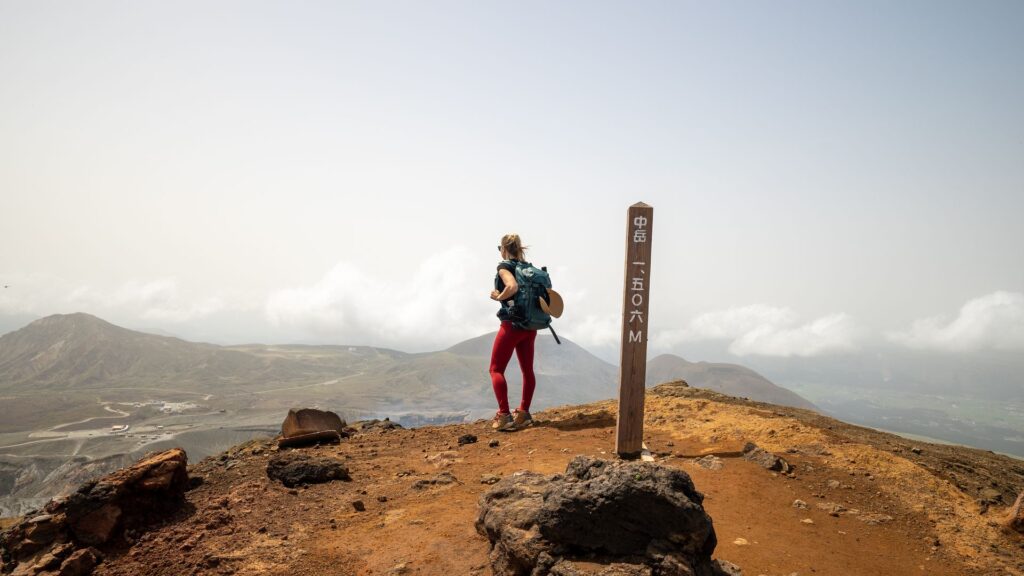
Day 3: Volcano Hike, Takachiho Gorge & Onbara Falls
- Drive to Mt. Aso region
- Hike Mt. Aso summit loop
- Kurokawa Onsen hot springs
- Drive to Takachiho Gorge
- Visit Onbara Falls
- Hotel: Ryokan Nanjoen
I’m due for a little adventure on Day 3, so I wind my way through the volcanic-shaped mountains (including the largest active volcano in Japan, Mt. Aso) and valleys in this region. Japan’s volcanoes are part of the ring of fire, which is a trend in my trips the last few years.
The trees here are almost too perfect to have grown naturally, but the rich and volcanic valley soil is pumping them full of life and green color.
Mt. Aso Volcano Hike
I continue on to Aso-Kuju National Park, home of the world’s biggest volcanic caldera (you can’t imagine the scope at 11 by 15 miles with a 75-mile circumference). Entire towns rest in the crater here.
I hike the Mount Nakadake-Mount Takanade Loop (pronounced “Nagade” and “Tagade”). These are highest of the 5 peaks and central volcanic cone of Mt. Aso, and leads to an overlook above the caldera spewing gasses and smoke. The trail proves to be a challenge with a steep descent and lots of slippery rocks that tested my leg strength, but the views are spectacular!
If you’re hiking in Japan make sure you have a map, ample water and your ten essentials. Photographers should pick up my favorite camera backpack which also happens to be made in Japan.
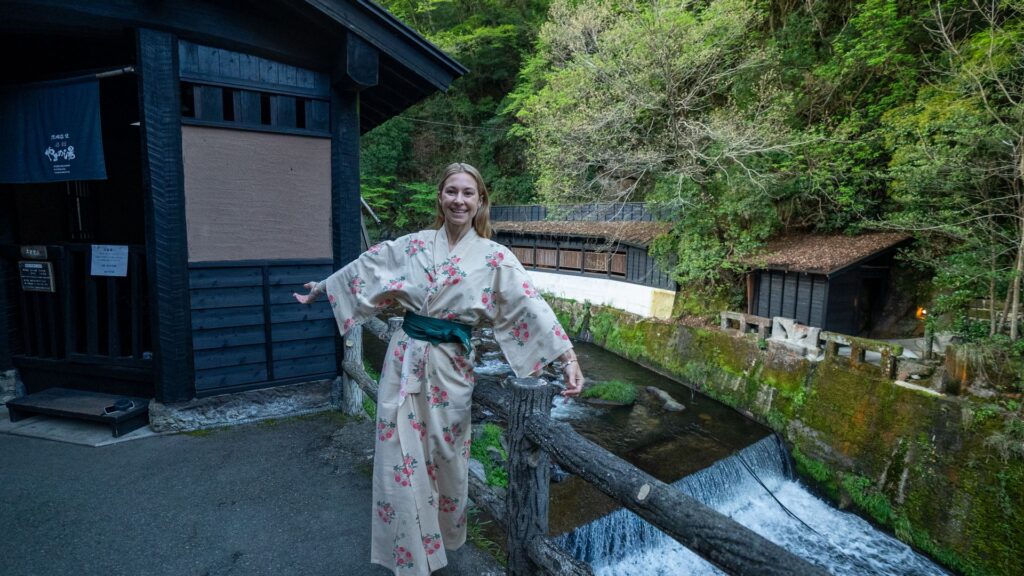
Kurokawa Onsen Hot Springs
After the hike, I stop for some much-needed ice cream and headed to Kurokawa Onsen: hot springs where Japanese B&B-style inns (ryokans) have been serving travelers for centuries. These are the place for a multi-course dinner and a hot soak afterward.
My ryokan is within the Kumamoto Onsen. The village built around the hot waters is beautiful and compact. There are ryokans dotted all over the hillsides, all connected with small footpaths where small shops with local honey, ice cream, and crafts can be found.
My first must: soaking in the hot waters. Right away, I broke the first rule on public bathing by going in my bathing suit. You’re supposed to go in the nude, but I’ve got the place to myself and let the warm waters sooth my sore legs and feet while overlooking the village below.

Beautiful Takochiho Gorge
It’s time for the winding drive to Takochiho Gorge. It’s on the touristy side, but amazingly beautiful. This deep gorge was formed by the lava flow of Mt. Aso and has layered rocks that line the turquoise-blue river.
Some are 300’ tall with waterfalls that cascade over the edges, which is a rare sight. A path follows the river for a ways and connects footpaths with vehicle bridges up and down the river.
After making my way to one of the higher bridges, I head back down, grab a mango and hibiscus soft-serve ice cream, and jump back in the car to drive to an overlook above the town.

Day 4: The Heavenly ‘Hells of Beppu’ & Sand Bath
- Drive to Beppu
- Beppu Beach Sand Bath
- Hells of Beppu tour
- Dinner steamed in “hell”
- Onbara Waterfall
- Hotel: Uminohotel Hajime
Hitting the road to Beppu, I have some ideas for stops and things to do while I’m in this resort city on Kyushu Island. The approach is gorgeous as volcanoes loom before me and Beppu Bay comes into focus. Hot springs, a buzzing local atmosphere with eateries and shops, and natural beauty show me I’m going to love this place.
Beppu Beach Sand Bath
We tend to associate bathing with water, but when you start traveling the world, you’ll find that other cultures practice “bathing” in natural elements from Cleopatra’s favorite, Dalyan mud baths in Türkiye, to forest bathing (Shinrin-yoku) in the Japanese Alps. And we can’t forget sunbathing (but always with SPF and protection)!
Sand baths are a big deal in Beppu Beach. When I discover a sand spa situated on the edge of the sea, it calls my name as the waves crash in peacefully. I settle into a furnished summer kimono and—why not?—get covered up to my neck in the onsen-heated sand.
I feel every muscle relax and let go of tension, while my pores open up and my skin is soothed by the minerals in the hot sand. Afterward, I rinse off in a nearby warm water spring. It’s a very cool experience and I recommend giving it a try!
Hells of Beppu
Beppu City has a claim to fame: the amazing onsens, or hot springs, that bubble and steam around the Kannawa and Kamegawa neighborhoods. Known as the Seven Hells of Beppu and one of Japan’s National Places of Scenic Beauty, I’m excited to tour all seven springs and discover what makes them so unique.
They lend the area an otherworldly feel. The biggest, Umi Jigoku, takes my breath away with its deep blue color and 650’ depth. But maybe Chinoike, also known as Blood Lake, is the most eerie with its sanguine, steaming waters that are estimated to be the oldest in Beppu.
There are nearly 100 alligators in Alligator Hell, or Oniyama Jigoku, a protected animal preserve in the Seven Hells. It’s not just the gators that make these springs unsuitable for a dip—they’re also nearly boiling at 210°F (99°C)!
Hell-Steamed Eats
Food steamed in hell might sound bizarre, but I’m here for new experiences and get to try some veggies cooked by the steam of the Seven Hells of Beppu. The area is famous for it!
There are lots of restaurants in the Kannawa neighborhood where brick chambers (hell ovens) sit on top of hot springs with a valve to control the hissing steam. I’m vegetarian, so I’m sticking with steamed veggies. But looking around, I see people dining on everything from fish and meat to pizza steamed by the onsens! It’s a must-try.
Onbara Waterfall
If you haven’t done a waterfall hike yet, today is a great day for it! Onbara Falls is just outside Beppu. This is my last stop in Kyushu before I retire to my oceanfront room at Uminohotel Hajime here in Beppu.
The falls are absolutely stunning and surprisingly accessible. After taking a winding drive up into the mountains, I park at the lot under a bridge just before the river and make my way down the 0.5-mile riverside trail to the falls.
The lush forest around me makes me feel almost enclosed on the way down. My first glimpse of Onbara isn’t all that impressive as water trickles down the rocks. But I move up to the base of the falls, look around the corner, and it all starts to make sense. This is Onbara!
One of the boulders has a statue sitting on top of it and moss, vines, and trees close in around the falls tightly. It’s a little cove of enchantment, and the water barrels down in a satisfying stream that makes me so glad I came.
Now I’m on to Uminohotel Hajime, my hotel for the night, to rest up before traveling to Kyoto tomorrow. I know this will be one of the highlights of my trip!

Day 5: Planes & Trains to Kyoto
- Fly to Osaka
- Bullet train to Kyoto
- Hotel: Node Hotel Kyoto
Today, I’m heading back to the airport, this time to fly to Osaka. It’s a bustling port city on the island of Honshu and I can see some incredible architecture with wafting smells of what’s sure to be delicious street food.
I won’t be staying here long, though. I’m due to catch a bullet train to Kyoto. This super-fast rail is so great to get around while I’m in Japan. It only takes about 15 minutes to get to Kyoto this way!
Once I arrive in Kyoto, I’m staying at the “industrial-chic” Node Hotel, part of Design Hotels. It’s in a great area, close to restaurants and some popular sites. Seems like the perfect place to settle in and begin my Kyoto adventures in the morning!
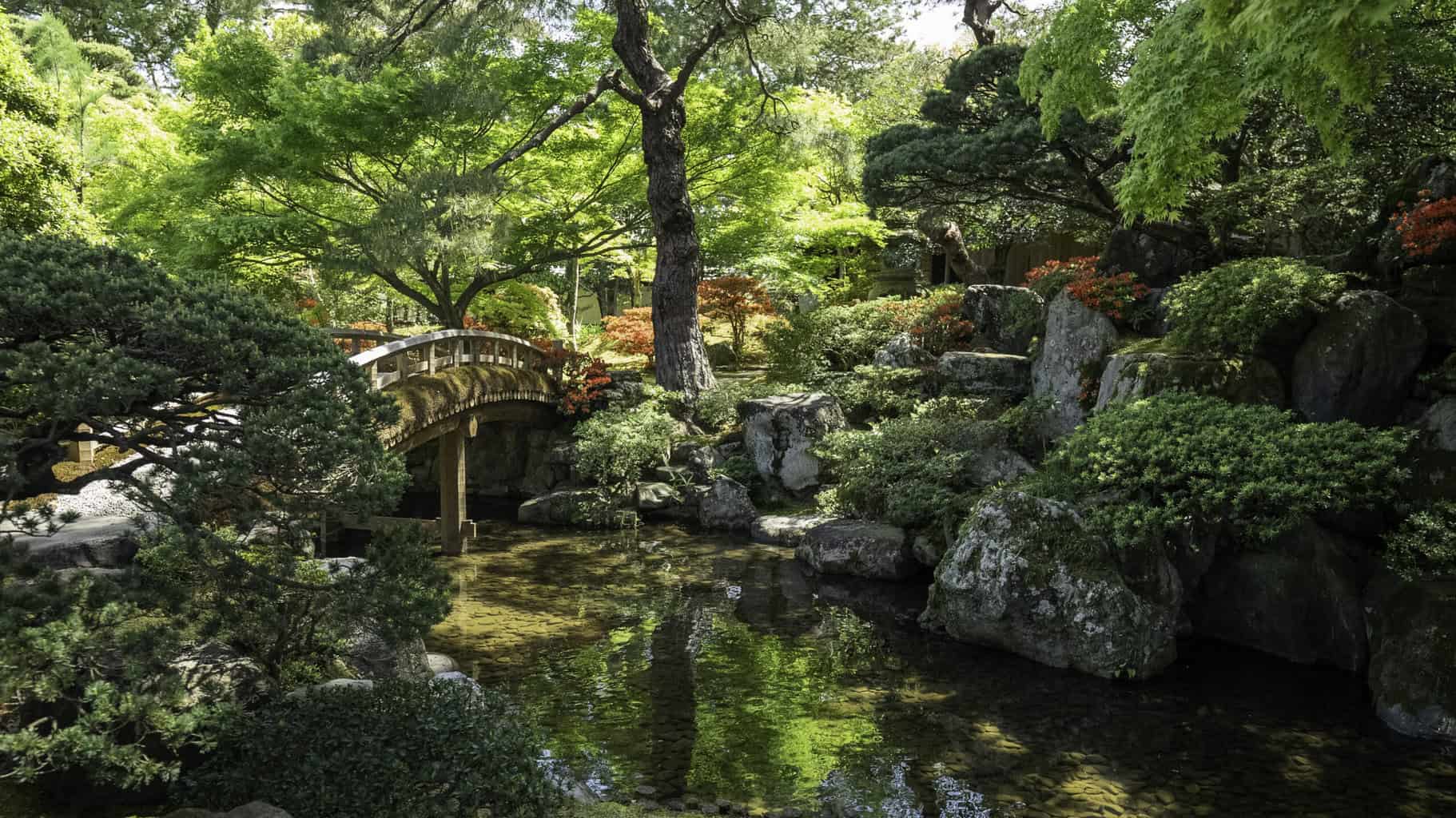
Day 6: Kyoto Gardens, Palaces & Temples
- Kyoto National Gardens and Imperial Palace
- Kyoto Shinkyogoku Shopping Street
- Gion District
- Golden Pavilion temple
- Dinner
- Hotel: Node Hotel Kyoto
Kyoto has the distinction of being one of the most well preserved ancient cities in Japan. It was Japan’s capital for over 1,000 years and that history is apparent in the 3,000+ beautiful temples and shrines, traditional architecture, and 17 of Japan’s 25 UNESCO sites. It’s a really popular place for tourists, so I’m going to try and get off the beaten path a bit today.
The City of Ten Thousand Shrines is also known for being a haven for Japanese food, so saying I’m excited is an understatement!
Welcome to Kyoto
My first impression is that Kyoto seems a little less foreign and easier to travel in than my adventures in Kyushu. This is also the first time I haven’t been in hiking clothes in a long time! This is an ancient city, but it’s also rather metropolitan, so it’s important to blend in.
I’ll be walking a lot today (about 10 miles), so breakfast at Node Hotel is a must. It’s a surprising array of fruit, scrambled eggs, salad, veggies, and minestrone soup (strange with breakfast but delicious). For the first time since I’ve been in Japan, I get to drink a coffee before 10 a.m.!
Kyoto National Gardens and Imperial Palace
My first stop is Kyoto National Gardens and Imperial Palace. There are over 50,000 trees and a stunning variety of colorful flowers in the gardens. I take my time strolling the footpaths and admiring how well-kept everything is in this traditional Japanese garden.
The Kyoto Imperial Palace, once the seat of Japan’s ancient dynasties, was actually rebuilt here in the mid-1800s. But it’s been designed to preserve the original look and style of the palace and full palace complex.
I’m here during cherry blossom season, something Japan and Kyoto especially are famous for. Pink and white blooms are everywhere and really make this walk something special.
Markets & Gion Geisha District
From here, I head back down toward Kyoto Shinkyogoku Shopping Street and find a huge, enclosed market in the city with hundreds of shops and restaurants. I decide on a mini pancake from a cute pancake-making machine and add a delightful donut and banana milkshake from the neighboring Koe Donuts.
I decide to walk around the Gion District, where the geisha work. School lets out and suddenly, the areas are extremely busy. The small, historic streets on the way to Kenninji, a massively popular Buddhist temple, just overflow with people.
Shops serving pale-green matcha ice cream and pork gyoza on sticks are everywhere. I pass what seems like hundreds of shops selling clothes, tea cups and kimonos. I find out that this is where many tourists rent kimonos for the day and then wander about, getting photos of themselves in front of temples and shrines.

The Golden Pavilion
By this time, my feet are getting tired and my back is a little sore. I hopped in an Uber to cross town and visit the Kinkaku-ji Temple (Golden Pavilion), converted from an area Shogun’s 13th-century home into the zen temple he wanted upon his death.
It’s not the original structure, which burned down twice: once during a Japanese civil war, and again in 1950 when an angry monk set it ablaze. The top two floors are covered in gold leaf and it’s truly beautiful as it glimmers in the sunshine. Across town is its sister temple, the Silver Pavilion, but it’s not covered in silver leaf.
With dinner on my mind, I find an udon place not far from my hotel and sit down to udon noodles and crispy tempura-battered veggies. I call it an early night and get ready to explore more tomorrow.
While I don’t have tons of time in Kyoto, I did find a ton of other places you may want to check out during your own visit:
- Fushimi Inari Shrine: Most important of Japan’s Inari shrines with orange torii gates leading to the mountainside shrine dating back to 711 A.D.
- Shimagamo Shrine: UNESCO World Heritage Site and one of the oldest shrines in Japan, surrounded by the Tadasu no Mori forest (“forest of purification”)
- Saannenzaka Road: Narrow, traditional street for souvenirs and beautiful architecture
- Maruyama Park: Philosophers walk for cherry trees in springtime
- Nijo Castle: Former Imperial Villa Nijo-jo Castle complex with Ninomaru Palace, Honmaru Palace ruins, and gardens
- Eikando Temple: Famous for ancient art like Buddha looking over his shoulder and fall foliage if you visit in autumn
- Arashiyama Bamboo Forest: Natural bamboo grove with a maze of green paths to wander

Day 7: Shizuoka Green Tea Plantation & Traditional Crafts
- Bullet train to Shizuoka Prefecture
- Mt. Fuji World Heritage Center
- Green tea plantation experience tour
- Hotel: Glamping at Mt. Fuji guest house
My next stop solo traveling in Japan is the prefecture of Shizuoka. Located on Japan’s Pacific coast, it’s home to one of Japan’s largest lakes and Mount Fuji, the tallest volcano in Japan. This morning, I take the bullet train from Kyoto to Shizuoka. It’s the 5th-fastest train in the world with speeds up to 200 mph!
Mt. Fuji World Heritage Center
I stop at the Mt. Fuji World Heritage Center to take in some incredible views of the volcano from the observation deck. The museum has interactive exhibits dedicated to Mt. Fuji and centuries-old artifacts. The entire WHS is made up of 25 sites that include pilgrimage routes, crater shrines, Oshi lodging houses, and volcanic features from lakes to waterfalls.

Green Tea Plantation Tour
I arrange a green tea plantation tour with Local Network Service Shizuoka. This prefecture produces about a third of the annual 80,000 tons of green tea in Japan and famously produces gyokuro (an organic, shade-grown artisan green tea for special occasions) on small farms.
My tour links me up with Noboru San, an award-winning farmer who has spent most of his life growing this tea, just like his father before him. He’s about 60, and he’s the youngest tea farmer in the area.
Fifty years ago, there were 100 farmers. Now, there are just 7. His son doesn’t want to continue the tradition, but he hopes that his grandson (now in junior high) will. If not, the youngest tea farmer could be the last in his family.
I learn that unlike less-expensive teas, gyokuro tea is harvested by hand (machine cutting isn’t viable). It’s only harvested once per year. The slower it grows, the less bitter it is. Black sheets covering the plants create shade that helps reduce the development time. Noboru tells me that growers used to use hand-woven straw mats to create shade, but the old ways have been replaced.
In the U.S., I find most green tea somewhat bland and bitter. But the tea I tried here was extremely flavorful and well balanced in sweetness and taste with hints of earthiness and seaweed.
Traditional Brewing & Tea Tasting
He shares that the brewing of tea should be done carefully, something time forgot in the western world. I first tried a variety of Sencha green tea, a more common and regular drink. Our last cup was the expensive gyokuro varietal.
Noburu-san added a measured pour of warm water to our cups, making sure it was the perfect temperature of 170° with 1 part leaves and 1.2 parts water (enough to just cover the leaves).
This can be repeated 5 times with the same leaves, and unlike American Starbucks ventis, this tea is served in small cups to be sipped and enjoyed while conversing about life and enjoying each others company.
We tried a taste and although I wouldn’t order it as a side dish, it did taste decent when adding some soy sauce and bonito flakes that soaked up the tea.
Glamping at Mt Fuji Experience
Wrapping up the tea farm tour, I head to the property of Satoyama Masanori Shintani, the owner of the traditional crafts center I’ll be visiting tomorrow, for a once-in-a-lifetime glamping experience in the shadow of Mt. Fuji. Talk about an amazing place to wake up! The property includes access to a bathhouse, kitchen, and outdoor kitchen with a grill. The views of Mt. Fuji are absolutely stunning.
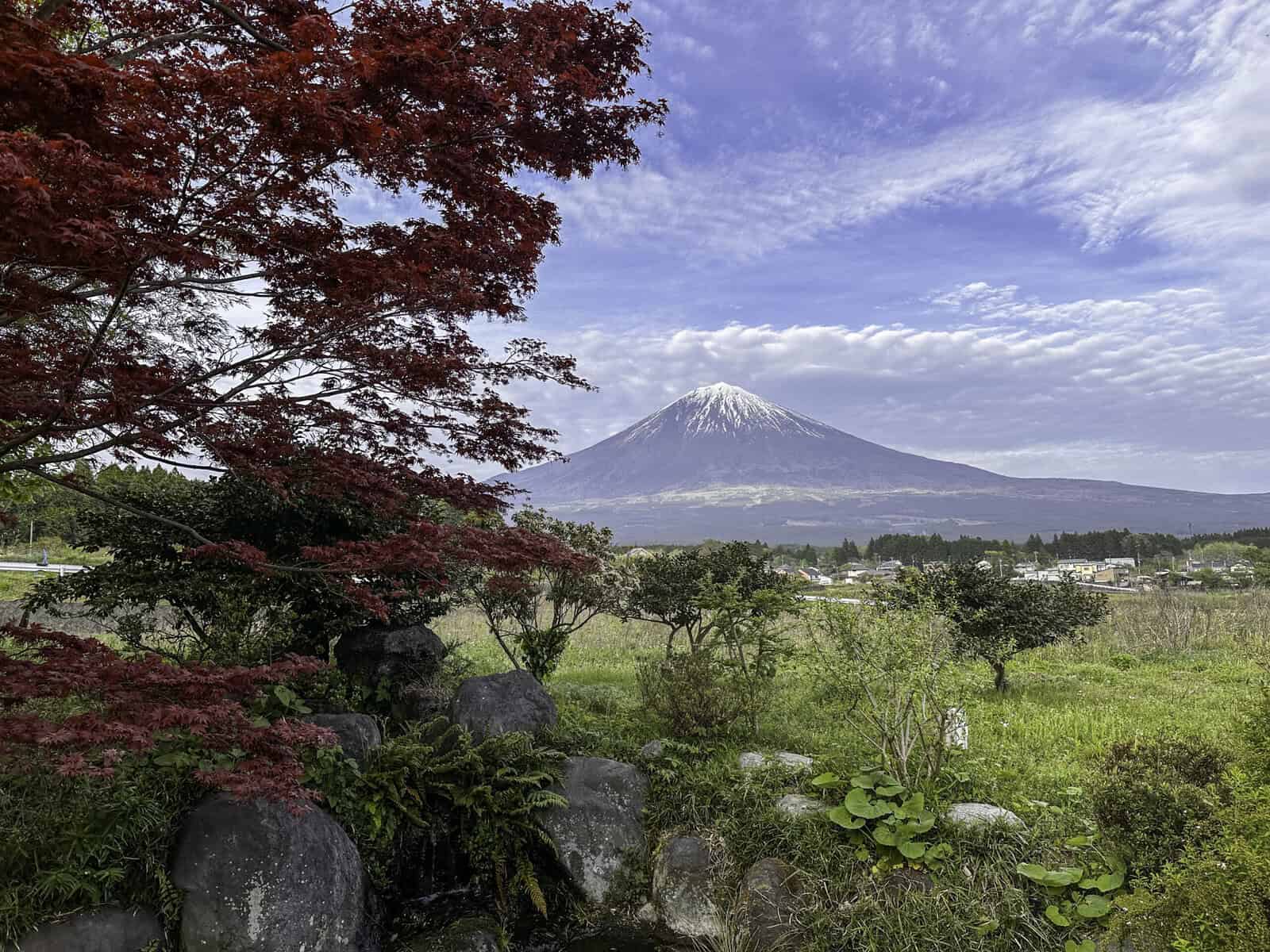
Day 8: Mt. Fuji Views, Traditional Crafts & Shiraito Falls
- Sunrise over Mt. Fuji
- Sumpu Takumi Shuku Traditional Crafts Center
- Guided Shiraito Falls tour in Mt. Fuji WHS
- Return to Tokyo
- Tokyo food tour
- Nakameguro cherry blossom stroll
Morning View at Mt. Fuji
From my glamping site, the morning view of snow-capped Mt. Fuji is breathtaking. The owner of Mt. Fuji Ecotours, Masanori Shintani, and I were up around 4:30 a.m. to come here in hopes of seeing the Diamond Fuji phenomenon when the rising sun perfectly aligns with Fuji’s beautifully symmetrical peak. Sadly, it was too overcast this morning, but the views of this natural Japanese icon were gorgeous nonetheless.
The early rise gives me a chance to sit down with Masanori Shintani, who is at the forefront of helping develop more sustainable and community based tourism in Japan. Masanori will be my guide for the rest of the day and take me to some of his favorite places and community-based tourism projects.
With my guide, it’s easy to envision how the historical and ecological significance of the highest (3,776 meters) and most famous of Japan’s volcanoes have shaped this culture. Over 1,000 years ago when Fuji was erupting, a lot local people created shrines and began praying to the god of the mountain to relent.
Eventually, it did, and this started a long history of cultural and religious importance to the Japanese people. The mountains’ snow melt also provides water for farming, fish, and life, further weaving it into local culture.

Sumpu Takumi Shuku Traditional Crafts Center
We’re off to the Sumpu Takumi Shuku, a traditional crafts center where I’m able to learn about and see handicrafts that have been handed down and preserved through tradition since the Edo times: Suruga bamboo creation, Japanese dyeing, ceramics, lacquer, and woodwork.
Shiraito Falls
Masanori brings me down to Shiraito Falls, which is part of the Mt. Fuji UNESCO World Heritage Site in the volcano’s southwestern foothills. On the way, we pass views of Otodome Falls (25 meters high) and know we’re in for a treat. We have no trouble getting to the base of the falls from a walking path just off the road.
Shiraito Falls is one of Japan’s most beautiful waterfalls, fed by volcanic spring water that remind me of hanging threads of silk as they cascade off the rocks and down into the river below us. Spanning 150 meters wide and flowing off a 20-meter cliff, I can tell this is a place I’m going to remember for the rest of my life.
Organic Rice Farm & Restuarant
My last stop on this short stay in Shizouka is to a local restaurant and shop owned by a young woman who grows organic rice. Her restaurant specializes in rice bowls, and after a great breakfast here, she shows me the fields where she was just starting this season’s rice.
She uses traditional techniques, farms organically without fertilizer, and hopes to inspire more young people to return rural Japan. She wants the next generation to continue cultivating the land and working with nature instead of leaving to go to the big city.
I’d love to stay, but it’s time for me to return to that big city—Tokyo—for one last night in Japan and head home tomorrow.
Return to Tokyo for Food Tour & Cherry Blossoms
I get back to Tokyo in time for a Tokyo food tour at 7:00 p.m., sampling delicious Japanese cuisine and street food with roots in every part of the archipelago. From there, I can’t resist checking out Nakameguro, one of the most iconic spots for viewing cherry blossoms in the city.
Cherry trees flank the banks of the Meguro River, standing in neat rows that come alive with color and softness as blossoms burst into bloom. I’m here in April, so it’s peak sakura season and absolutely perfect for a scenic stroll by the water. I can’t think of a more beautiful place to end my solo traveling tour through Japan.
In the morning, I’ll board a flight to Los Angeles and reflect on the adventures I’ve had while solo traveling in Japan, the things I’ve learned, and the people I’ve met.
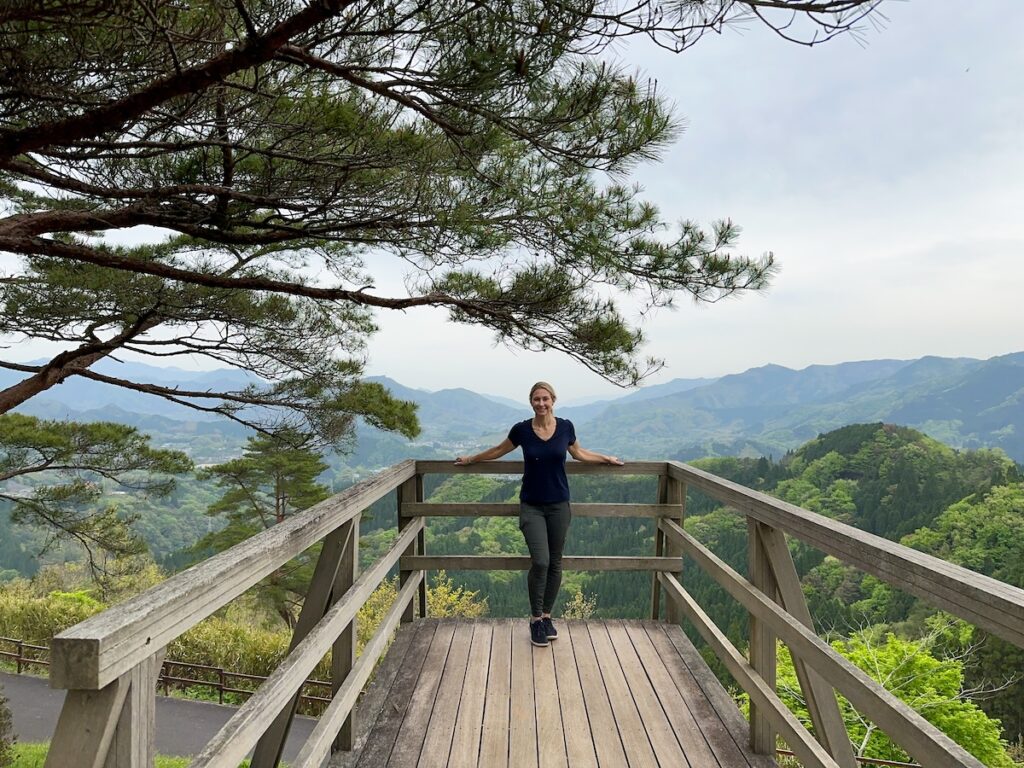
My Experience Solo Traveling in Japan for 8 Days
I have learned so much on this visit to Japan. Tokyo might be the city of industry, but in the more rural areas, people are still fighting to keep a slower and more traditional way of life. I think there are so many lessons in this that we can take to heart in our own lives, too.
Doing this trip solo made it really special for me—I was able to connect with the people I met and the places I visited in a deeper way. From sitting down with generational green tea farmers and organic rice farmers-turned-restaurateurs to traditional craft experts that were willing to double as my guide for the day, I realized that a big part of what makes Japan so alluring and fascinating isn’t just the natural wonders, the temples, or the shrines.
It’s the people living here and the way many of them uphold tradition and the ancient ways so proudly. Some of the “old ways” could be made easier with modern-day technology, fertilizers, machinery, and shortcuts, but the sentiment I picked up on here was that shortcuts don’t have the heart and soul of tradition.
I know I’ll come back one day soon to do some more exploring—I’ve seen a lot of Japan, but I’ve seen enough to know that this stunning country has so much more to offer than a single trip could ever pack in.
Pin Me





What’s on your Japan Bucketlist?
My father enjoyingbus tours to niagara falls from nyc. I have plan to enjoy the Kyoto Garden Waterfall in London. I am very excited about this tour.